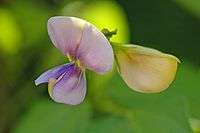Asparagus bean
| Asparagus bean | |
|---|---|
 | |
| Species | Vigna unguiculata (L.) Walp. |
| Cultivar group | 'sesquipedalis' |
| Cultivar | Asparagus bean |
The asparagus bean (Vigna unguiculata subsp. sesquipedalis) is a legume cultivated for its edible green pods containing immature seeds, like the green bean. It is also known as the yardlong bean,[1] long-podded cowpea,[1] Chinese long bean,[1] bodi/bora,[2] snake bean, or pea bean.[1] Despite the common name of "yardlong", the pods are actually only about half a yard long, so the subspecies name sesquipedalis (one-and-a-half-foot-long; 1.5 feet (0.50 yd)) is a more accurate approximation.
A variety of the cowpea, the asparagus bean is grown primarily for its strikingly long (35 to 75 centimetres (1.15 to 2.46 ft)) immature green pods and has uses very similar to those of the green bean. This plant is in a different genus from the common bean. The many varieties are usually distinguished by the different colors of the mature seeds. It is a vigorous climbing annual vine. The plant is subtropical/tropical and most widely grown in the warmer parts of South Asia, Southeast Asia, and southern China.
Cultivation
The pods, which can begin to form just 60 days (2.0 months) after sowing, hang in groups of two or more. They are used as vegetable when they are picked before they reach full maturity; however, overlooked mature pods can be used like dry beans. When harvesting, it is important not to pick the buds which are above the beans, since the plant will set many more beans in the future on the same stem. The plants take longer to reach maturity than bush beans, but once they start producing, the pods are quick-growing and daily checking and harvesting is often a necessity. The plants can produce beans until the first frost. The plant attracts many pollinators, specifically various types of yellowjackets and ants.
Uses


The crisp, tender pods are eaten both fresh and cooked. They are at their best when young and slender. They are sometimes cut into short sections for cooking uses. As a West Indian dish, they are often stir-fried with potatoes and shrimp. In Odisha, India, they are used to make a variety of dishes, especially a sour dish - ଝୁଡ଼ୁଙ୍ଗ ବେସର [judunga besara] cooking along with mustard sauce and lime. They are also used in stir-fries in Chinese cuisine and Kerala cuisine.
In the Philippines, they are widely eaten stir-fried with soy sauce, garlic, and hot pepper and in an all-vegetable dish called utan, or are stewed in bagoong-based dishes such as pinakbet and dinengdeng. Other Filipino dishes that have yardlong beans as ingredients are sinigang and kare-kare. Yardlong beans are also separated from the pod and are cooked with the buds of the alukon tree (Alleaenthus luzonicus) and other vegetables in a dish called agaya in northeastern Luzon.
In Malaysian cuisine, they are often stir-fried with chillies and shrimp paste (belacan) or used in cooked salads (kerabu). Another popular option is to chop them into very short sections and fry them in an omelette.
The plant is easy to grow in areas with hot and humid summers where other green bean varieties may succumb to heat damage in summer, and as such is worthy of more cultivation in these areas. This plant is particularly easy to grow in the Southeastern United States and southerly Midwestern United States, where it is not currently grown commonly.
In Suriname cuisine, they are served with roti. Similarly, in Trinidad and Tobago and Guyana it is a Indo-Trinidadian/Indo-Guyanese dish that fried or curried and served with roti or rice.
Nutrition
They are a good source of protein, vitamin A, thiamin, riboflavin, iron, phosphorus, and potassium, and a very good source for vitamin C, folate, magnesium, and manganese.
| Nutritional value per 100 g (3.5 oz) | |
|---|---|
| Energy | 197 kJ (47 kcal) |
|
8.35 g | |
|
0.4 g | |
|
2.8 g | |
| Vitamins | Quantity %DV† |
| Vitamin A equiv. |
5% 43 μg |
| Thiamine (B1) |
9% 0.107 mg |
| Riboflavin (B2) |
9% 0.11 mg |
| Niacin (B3) |
3% 0.41 mg |
| Pantothenic acid (B5) |
11% 0.55 mg |
| Vitamin B6 |
2% 0.024 mg |
| Folate (B9) |
16% 62 μg |
| Vitamin C |
23% 18.8 mg |
| Minerals | Quantity %DV† |
| Calcium |
5% 50 mg |
| Iron |
4% 0.47 mg |
| Magnesium |
12% 44 mg |
| Manganese |
10% 0.205 mg |
| Phosphorus |
8% 59 mg |
| Potassium |
5% 240 mg |
| Sodium |
0% 4 mg |
| Zinc |
4% 0.37 mg |
|
| |
| |
|
†Percentages are roughly approximated using US recommendations for adults. Source: USDA Nutrient Database | |
A serving of 100 grams of yardlong beans contains 47 calories, 0 g of total fat, 4 mg sodium (0% daily value), 8 g of total carbohydrates (2% daily value), and 3 g of protein (5% daily value).
See also
References
- 1 2 3 4 "Vigna unguiculata subsp. unguiculata group sesquipedalis". Germplasm Resources Information Network (GRIN). Agricultural Research Service (ARS), United States Department of Agriculture (USDA). Retrieved 15 December 2017.
- ↑ Shirley Hall. "Bodi, our favourite bean".
External links
| Wikimedia Commons has media related to Asparagus beans. |